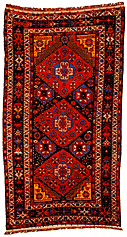|
|
|
|
Especially gentle,
high-quality carpets are being produced in Baku and all over the Absheron
peninsula from the most ancient times. The Baku carpet style is a group
which includes these types:
1-"Baki"
2-"Khila-buta"
3-"Khila-afshan"
4-"Surakhani"
5-"Novkhani"
6-"Goradil"
7-"Fatmayi"
8-"Findigan"
9-"Gaadi" (or Dagli)
10-"Zili"
Titles of the majority of the listed types are related to the names of the
old villages of Baku and the whole Absheron
peninsula. But it does not mean that each type is usual
just for a single place which gave its name to this type. For example, "Khila-buta"
carpet has received its name from the village of Khila (Amirjan) while
carpets of such pattern are produced in all other carpet-weaving centers
of Baku-Absheron as well. Sometimes the name of a carpet type even doesn't
have any connection with a certain place at all.
Carpet weaving really is
a hard work. In some cases the complexity of this process has found its
reflection in the name of a carpet type. For example, one from the "Khila-buta"
varieties is named "Gizgaridan", meaning a carpet, that
makes a weaving girl grow old - so long and complicated the process of its
manufacturing is.
The local nature and dominant colors of the environment necessarily find
their reflection in a carpet style's "color language". Dark-blue
and yellow tints - colors of sea and sand, are typical for the carpets of
the Baku group.

|
| Traditional
motif with three gells in the middle field |
|
The main element of
composition of this group of carpets is Buta - one of the richest
ornamental elements of Azerbaijan's decorative arts. Buta is
frequently used for expression of the fire, flame images.
Chains of these elements are traditionally used either framing carpet's
middle field or in the shape of helical tree branches. These chains are
integrating separate main and auxiliary decorative elements of a carpet
into a complete composition. Besides, they serve to integrate
compositionally several Gels - special element groups, which are
located horizontally and vertically in a carpet. Gels are
medallions, decorating a middle field of a carpet. Sometimes Buta
itself is placed in the middle of a Gel. In such carpets the fourth
part of Gel happens to be repeated in each of four corners of a
middle field, with addition of some elements symbolizing traditional items
of household activities, such as wheel of well ("guyu charkhi"),
small metal shovel ("kurek"), candlestick ("shamdan"),
butterfish ("yagdan"), images of animals, vegetative
elements.
Every new composition
with Gels usually appeared as expression of a joy, celebration,
wedding. For example Gels, referring to as "Khoncha",
are symbolically featuring a bride's adornments and traditional big plates
with sweets. And the shape of the "Gaadi" carpet's Gels
reminds of the big round trays traditionally used during most of the
crowded ceremonies. Often the word "Potnus" (tray) itself
is used to name all Gels of such carpets, while only the central
medallion is named "Alma" (apple) or "Goghal"
(pancake).
Reflection of the knowledge about celestial objects in some carpet
compositions of the Baku group seems to be rather interesting as well. For
example, in carpets representing the "Novkhani" type,
there are compositions with very peculiar Gels: in their center
there is a small medallion called "Kosher ayagi" (leg of
a camel) and twelve round elements are surrounding this "Koshek
ayagi". These images are treated by some experts as twelve
zodiacal constellations.
|